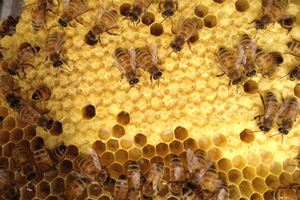- All-In-One Beekeeping for the Bees
- +1-608-728-8233
- info@beepods.com
It’s Time to FEED Those Bees!!!

Winter is coming.
Yes, we know, it happens every year.
We all know what that means, the bees are making their final preparations for winter and you should be, too. They are currently occupied finding and storing every last scrap of food they can find. This is sometimes easier said than done, as late blooming plants are far less plentiful than the blooms of summer.
We thought you might enjoy a little pictoral tutorial on how we prepare our bee syrup (because, yes, Sandy, our alchemist, loves to cook out of large pots and take pictures).
Fall syrup is thicker, so it resembles honey and bees tend to store it for winter. Athough we don’t harvest honey from our Beepods in the fall, we do like to supplement their food so they can make it through the winter a with a little less stress. One gallon of heavy syrup (2:1) may increase colony reserves by about 7 pounds.
It is important to use just plain white granulated sugar, not brown sugar, molasses, sorghum, or fruit juices as these all have impurities that could cause dysentery in bees. Confectioner’s sugar has cornstarch in it, which is also not good. I’ve found some older recipes that use of cream of tartar to keep fall syrup from crystallizing, but most people don’t do this anymore because it, too, could be bad for the bees. Bee dysentery is not a disease caused by a pathogen but a condition caused by poor quality food. It appears as spots of feces around the hive entrance, or inside the hive, and is easily confused with Nosema, which is caused by a pathogen.
Where you source your white sugar doesn’t really matter. We generally look for sugar labeled as cane, but beet sugar has the same molecular structure as cane sugar. Refined table sugar (sucrose) is a disaccharide derived from glucose and fructose, and has the molecular formula C12H22O11.
This year I purchased sugar from a couple different places. Notice how only one clearly states its cane sugar:


There are few things we can add to our syrup to make it easier on the bees’ digestive systems and a bit more nutritious. With all of this in mind we’d like to share a recipe for sugar syrup that we use for our honey hives. Now, we tend to make large batches, but don’t worry, we’ve attached a calculator and a recipe for a scaled down version of what we produce. We’ve also attached a link to a very good Mother Earth recipe. Similar, but not the same. There are many varying recipes. And there is a product called Honey B Healthy that you can use instead of the Beepods lemongrass/vinegar/salt mixture.
Start with a big pot (or two!) Heat JUST under 5 cups of water (4.864 cups if you want to be exact, but you’ll be just fine to round up to 5 cups).

Do not boil!!
Add 5 lbs of sugar and mix to dissolve. After the sugar has dissolved (by mixing mixing mixing!), you can add 2.5 tsp of apple cider vinegar, a half teaspoon of salt and .5 ml of lemongrass essential oil.


looks yummy, doesn’t it?

well, it smells HEAVENLY!!!!!
Give your mixture some time to cool down to room temp before you jar it up in your mason jars. (Remember those? They came with your Beepod!!).

Before you install it upside down in your Beepod, you will want to invert it over the grass, so it can equalize a bit and stop dripping. Nobody needs a messy hive! Next, mark the liquid level with a sharpie and make sure the mark is facing a window. Then you can do quick checks through the window to see how fast they are consuming the syrup.
Beepods Fall Feeding Syrup

5 cups water, heated
5 lbs sugar
2.5 tsp apple cider vinegar
½ tsp salt
½ ml pure lemongrass essential oil
Heat water till just under boiling, then add sugar and stir to dissolve. Once sugar is fully incorporated, you can add the remaining ingredients and leave to let cool before transferring to your feeder jars.
This is a handy-dandy syrup calculator I highly recommend using:
Latest posts by Sandy West (see all)
- It’s Time to FEED Those Bees!!! - October 27, 2015





